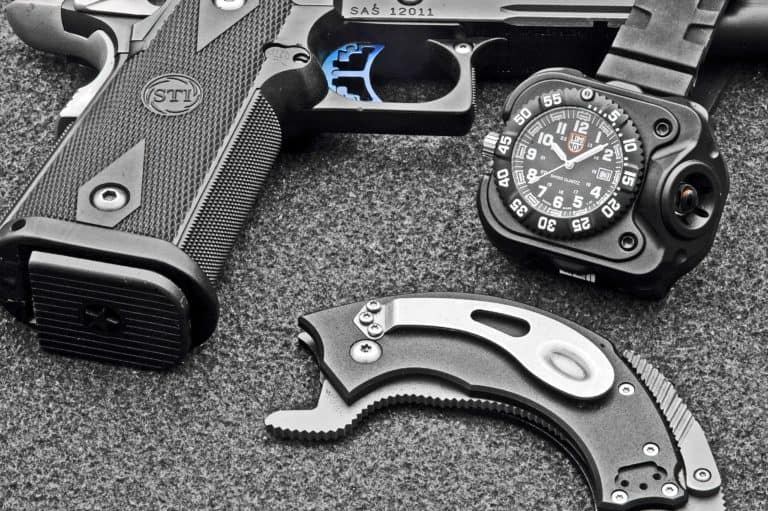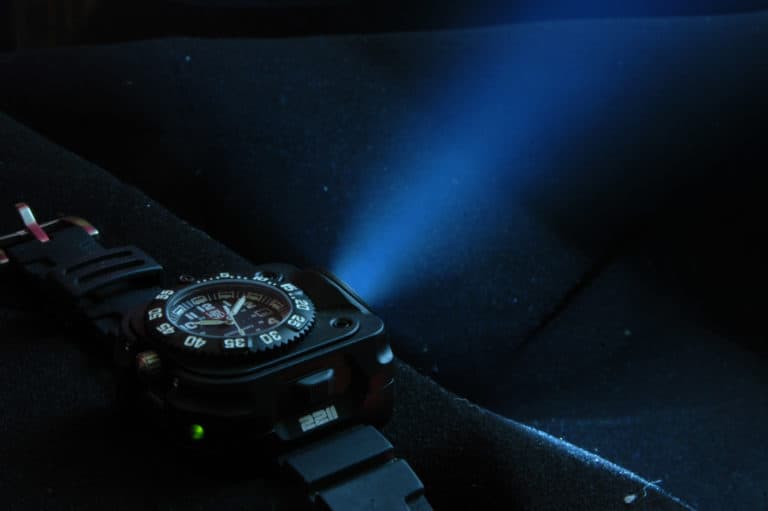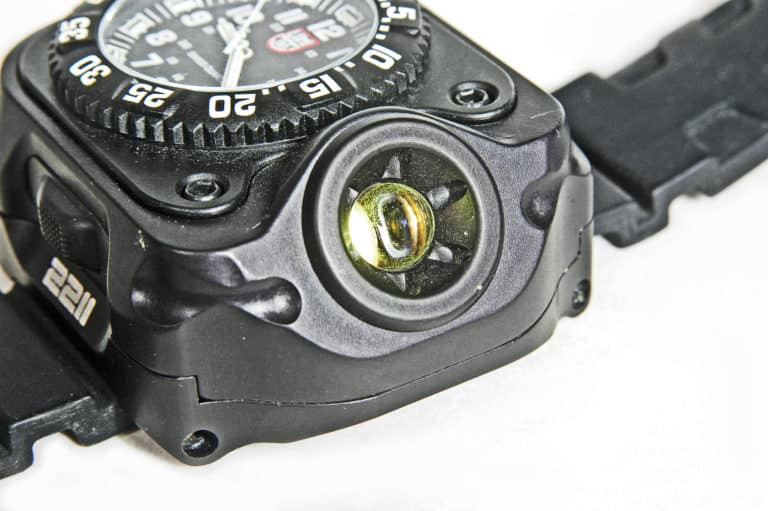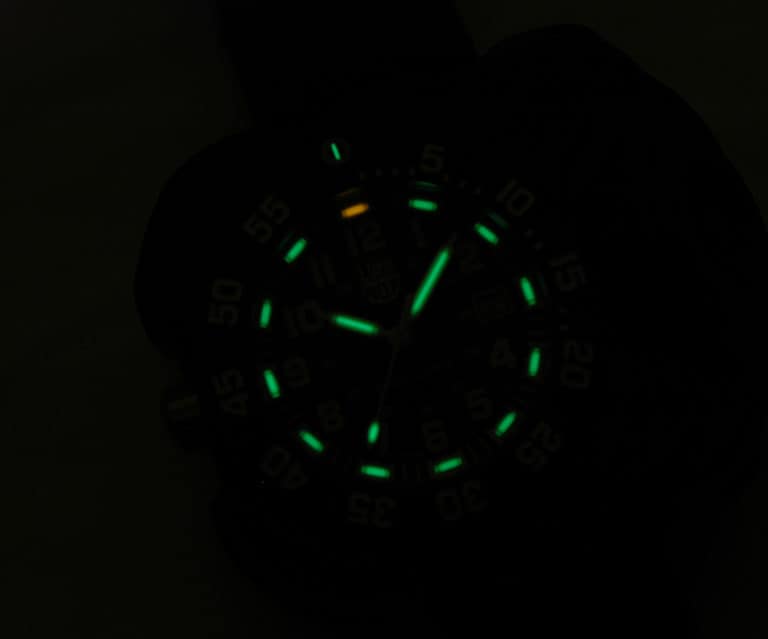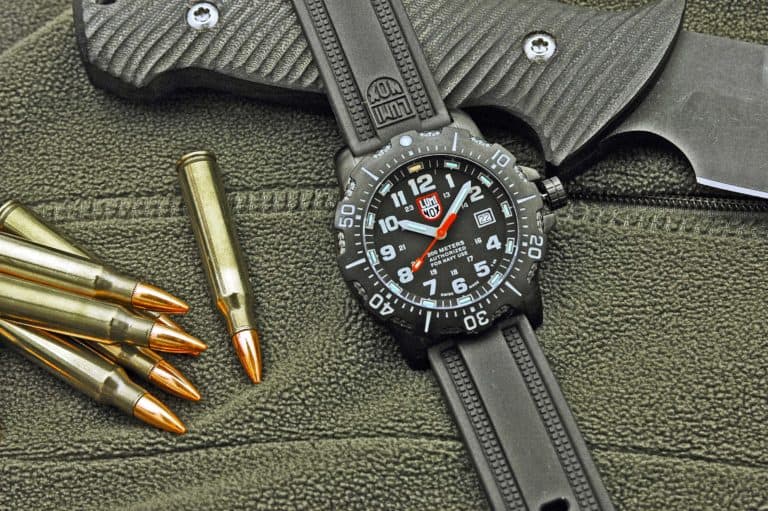Exclusive: SureFire/Luminox 2211 Wrist-mounted Light
SureFire’s 2211, a joint endeavor with the Luminox watch company, combines the proven lighting technology of both companies to create an always-visible watch that also has a brilliant, 300-lumen wrist-mounted light.
Human beings don’t see particularly well in the dark. While that observation surprises exactly no one, what is surprising is how easily we overlook it when planning the best way to protect against violent attacks, the majority of which occur in poor light. The question isn’t just being able to aim correctly: more commonly, the problem is identifying what (or who) an object is to determine whether or not you should shoot at it in the first place.
Unfortunately, there are no perfect options. Handheld lights occupy one hand, which may otherwise be better used to support the gun, open a door, etc., not to mention the problem of aligning the light in the general direction in which the gun is pointed. Gun-mounted lights do away with most of those problems, but are devilishly hard to conceal. Worse, people tend to use them to identify things or people by pointing the light—and therefore the gun—at them, which violates one of the cardinal rules of gun safety and invites tragedy. (“Son, is that you?”) To these two options, SureFire has added a third: the wrist-mounted light.
At 5 oz. (the polymer version is over an ounce lighter), the 2211 isn’t a flyweight, but you get used to it. The more you wear it, the more aware you become of its physical dimensions, and you’re less likely to bang it into things. Shown with customized STI 2011 pistol and Krudo Knives Snag 2.0.
There Where You Need It
Originally offered as a dedicated wrist-mounted light, the latest iteration is the 2211 which combines SureFire’s proven LED technology with a wristwatch. There are currently two versions: the recently-introduced Signature model, with a suggested retail of $199, that features a polymer body and quality quartz movement, and the original higher-end model ($649) featuring a hard-anodized aluminum body and a watch made by Luminox, the well-known watchmakers who first came on the scene making dive watches for the Navy SEALs.
These two companies are an excellent match: SureFire revolutionized the lighting world — especially the tactical side of the house — decades ago with lights such as the 6P and 6Z, impossibly bright tactical flashlights that were the size of a roll of quarters but put out far more light than the D-cell duty lights of the day. 60 lumens is still a lot of light, but thanks to the explosion of LED technology, which SureFire has led, lights the same size as the earlier offerings literally put out ten times the light
The broad, upwards-angled beam of the 2211 is rated at 300 lumens at its highest mode, with two lower utility settings of 60 and 15 lumens.
While Luminox makes excellent watches, like SureFire, they’re perhaps best known for their lighting. When they first came on the scene, watches were lit either by luminous paint that had to be “charged” by exposure to light or by some kind of electronic light on the dial (such as Timex’s “Indiglo” watches). Luminox, however, used tritium tubes (like the ones in your pistol sights) on the markers and hands. No charging, no button to push: they’re always on, and always bright.
The original 2211 that combines the two has a black mil-spec hard anodized aluminum body with the watch crown (traditionally at either 3 or 4 o’clock) located at the 9 o’clock position, and the lens of the light on the right side. The watch module, which appears to be held in place with four small allen head screws, has a Swiss quartz movement and a black dial with green tritium markers on all three hands and on the 1-11 numbers on the dial (12 o’clock is in yellow). Although this is obviously not a watch to submerge, it has the customary diver’s bezel, boldly marked with the minutes in white, with a green tritium dot located at the 12 o’clock position. As is standard on dive watches, the bezel rotates only counter-clockwise, and ratchets crisply into place when turned. The unmarked black strap is a soft, comfortable rubber that’s much more comfortable than the plastic bands on some other dive watches, but may be a bit loose for wearers with thin wrists (the Signature model uses a nylon Zulu-style strap). It’s held closed with a seriously sturdy steel buckle. Now for the light.
The light module has been carefully angled upwards so that on the wrist it will point downrange when the hand is grasping a pistol. The angle appears to be optimized for a raked-back grip angle such as a Glock: with the more vertical M1911 angle, the center of the beam posts somewhat higher than the sights.
Rechargeable via a micro-USB port located on the left side of the watch beneath the crown (which is why you probably don’t want to submerge it), the 2211’s wide-angled light is activated by a pair of finely checkered rubber switches: one each on top and bottom. Pushing both turns on the LED at the low 15 lumen setting. Holding them in will cycle to the medium setting (60 lumens) and then to high, with a little less than a second delay between settings. Pushing either button will turn it off. Pushing either the top or bottom switch by itself hits the high beams, for an output of the full 300 lumens. Pushing it again quickly will lower it to the low 15 lumen level: after that, a second push of either button will turn it off. The light module itself has been carefully angled upwards so that on the wrist it will point downrange when the hand is grasping a pistol. The angle appears to be optimized more for the raked-back grip angle of Glock pistols, where the sights appear near-centered in the center of the beam, as opposed to the more vertical M1911 angle, where the center of the beam posts somewhat higher than the sights. While it will work well with a long gun if you take the 3-gun style forward grip, using a traditional hold will leave you with a rifle-shaped shadow in a large portion of the beam.
The left side of the 2211, between the 7 and 8 o’clock positions, has an LED power indicator that turns on with the light. Green indicates full power: yellow is low. It blinks red when fully depleted, and, when charging with the included cable, the red LED stays constantly on until charging is 90% complete and it turns green. Battery runtime on the high, 300-lumen setting is about one hour, and charging can take up to three hours when the battery is completely expended.
The Luminox advantage is their self-luminous markers, which are the same type of tritium capsules used in night sights. All are green except for the 12 o’clock tube, which is yellow to help you tell time quickly in the dark.
Hands On
Enough description; on to how it works. During my test period, both the watch and light functioned flawlessly, and I was surprised by how often I used it. The light seemed to hold a charge for an inordinate period of time, and always came on in whatever setting it was supposed to when I hit the switches. At 5 oz. the 2211 isn’t a flyweight (the polymer Signature comes in at 3.75), but in the current world of enormous bling-based watches, was lighter on the wrist than you might think. Once it was on my wrist, I never really noticed the weight, thanks in no small part to the comfortable rubber strap. Though its embarrassing to tell, I got so used to it that one night I found myself scrabbling around in my car searching for a flashlight in the dark, completely forgetting I had one strapped to my wrist. I only accidentally activated it twice, both times during hunting season when I hadn’t buckled the watch tight enough and it rotated around my wrist.
Even when I didn’t have the light turned on, the watch component performed its intended purpose, with the bright tritium-lit dial telling me what time it was no matter the conditions. While I did not submerge the 2211, I had it out in some pretty thorough rainstorms while hiking and never had a problem with water entering the charging port, nor did sub-zero temperatures affect it or seem to reduce battery life.
Although the 2211 is marketed more towards tactical use, that’s not its only application: it’s very convenient for runners who don’t want to carry a light in their hand, and for general outdoors use it’s added insurance against getting caught in the dark.
Size-wise, there’s no disputing the 2211 rides higher than most watches: it’s about twice as tall as my Luminox Field Chronograph. If you tend to wear tight cuffs, it won’t fit under them. In either a suit or a leather jacket, though, it fit comfortably inside the sleeve. Despite the size, most people that I interacted with didn’t seem to notice, and very few commented on it. In our universally-connected world, people may just assume it’s a smart watch, even though to be candid, it’s larger than most of those.
There are three options for lighting while using a weapon, none of which is a perfect solution to the full spectrum of problems (left to right): weapon-mounted light, SureFire’s original 6Z handheld, and the Luminox 2211 wrist light. Ideal defensive prep includes knowing the strengths and weaknesses of all three.
Having spent a fair amount of time in the field with law enforcement, I can appreciate the need for a light that’s instantly accessible and strapped to your body where you a) can find it, and b) can’t lose it. In that setting, the greatest risk of the 2211 appears to be snagging it on things. If you’ve ever taken a close look at a well-traveled duty pistol, they’re usually beat up from getting knocked into things like door frames. In the case of the 2211, the screw-in pins holding the rubber strap in place make it unlikely you’d knock it completely off, but snagging it on something you’re moving past in a hurry could certainly move your wrist in a direction you hadn’t planned on. Solution? The more you wear it, the more aware you’ll become of its physical dimensions, and therefore the less likely you’ll be to bang it into things. If you work extensively in close quarters, however, this may be a problem for you.
The second issue unique to the 2211 is how to turn it on. Since it’s on the back of your support hand, you can’t use that hand, so you either have to use your dominant hand to turn it on before you draw your pistol (which is what SureFire recommends), or turn the watch towards your strong hand after you’ve drawn your pistol and use your strong side thumb to turn it on. SureFire strongly recommends against this, and for good reason: it carries with it the risk of negligent discharge, especially considering sympathetic movement among the fingers. Another option is to activate the switch against some other hard object, such as spare mags on the belt. That’s the bad news about having the light away from your palm. The good news is that once it’s on, the hand and fingers are free to do whatever is needed—whether that’s take a two-handed hold on a pistol, reload, identify something, open a door, go hands-on, or whatever else the situation demands.
The third question to ask about having a wrist-mounted light is the likelihood of the light turning into an ersatz aiming point for the bad guy. There’s evidence to suggest that, when confronted by someone with a flashlight, criminals tend to shoot at the light. This problem is the same whether you have a weapon-mounted light or a handheld light using virtually any of the popular light techniques that keep the light close to the centerline of your body, including the Harries, Rogers/SureFire, and to an only nominally lesser extent, the neck index. Only something like the FBI technique, where the light is held well away from the body, can seriously limit that chance. If you currently use any of the more closely-held light techniques, however, and are comfortable with their risk, the only added liability from having the light on your hand, rather than in it, is that you can’t drop or throw it away quickly. This is either a risk or a selling point, depending on what you need at that moment, and it’s hard to know ahead of time which it will be: I personally suspect more people have needed lights they have dropped in fights than haven’t been able to get rid of one fast enough, but that is purely a guess.
The ANU (Authorized for Navy Use) is one of the latest iterations of Luminox’s popular Navy SEAL dive watch. Although the SEALs no longer allow their name to be used for commercial purposes, the Luminox story began with creating a watch to meet their needs and this is its latest evolution. The knife is a Mil-Tac fixed blade.
A Good Partner
While I was working with the 2211, I was also sent a Luminox ANU for review. The latest iteration of their justly-popular Navy SEAL watch, since the SEALs have apparently grown a bit weary of commercial use of their name (and there’s more than other watch company that’s provided watches for them), it is currently marked “Authorized for Navy Use.” Subdued as is fitting for its intended use, the stainless steel case is darkened with a black PVD finish. Water resistant to 200 meters, the ANU has an antireflective sapphire crystal as well as a screw-down crown and caseback, both standard features for dive watches, and a ratcheting unidirectional bezel. Hands and hour markings, along with the minute markings on the bezel, are in grey and the date is in white: all else is black, including the soft rubber strap.
Whether or not the 2211 fits your sets of needs is an individual question as what pistol you should carry, and in what holster. Col. Jeff Cooper once described the advantage of the handgun as being that it is “worn” rather than “borne,” and that’s the advantage it offers. For those looking for an instantly-accessible, bright light that’s with you all the time, the 2211 is an option well worth considering.
To learn more, visit:
https://www.surefire.com/illumination/wristlights/2211-luminox-wristlight-gen2.html
https://www.luminox.com/watch-collection/sea/anu-4220-series/xs-4221.html

